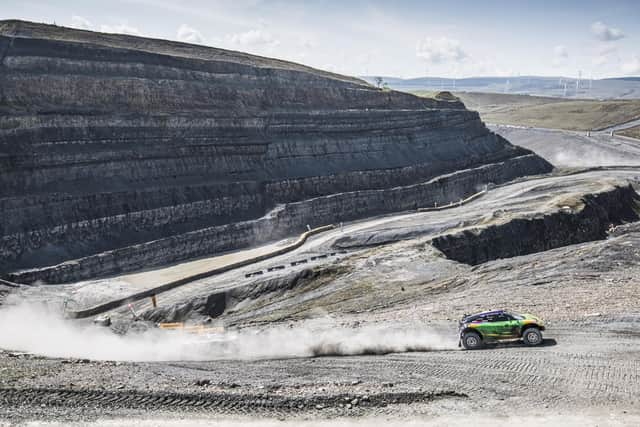First look at the new hydrogen-powered racing car that will debut at Hydro X Prix off-road rally in Scotland
The world’s first hydrogen-powered racing car has been revealed to the public ahead of its debut rally in a disused coal mine in Scotland.
The futuristic machine, which runs on hydrogen fuel cells and emits only water from its exhaust pipes, is one of a new generation of vehicles being developed to compete in motorsports without polluting the planet.
Advertisement
Hide AdAdvertisement
Hide AdThe Pioneer 25, unveiled in London on Thursday, will be the official competition vehicle for a new international racing series for hydrogen-powered vehicles, Extreme H, which is launching a full competition series next year.
According to the designers, it is faster and more furious than its electric equivalents – with a 550-horsepower output that drives acceleration of zero to 62 miles per hour and allows it to scale gradients steeper than 45 degrees.
Anyone wanting to see how the supercar performs will be able to do so next month, when it is taken through its paces in a debut appearance at an international off-road rally for electric vehicles being staged in Scotland next month.
In contrast with traditional motorsports, which use climate-warming fossil fuels, the two-day Hydro X Prix event at Glenmuckloch, an abandoned opencast coal mine in Dumfries and Galloway – part of the Extreme E series – will be carbon-neutral.
Accelerating to a greener future


Hydrogen power is the next step for eco-friendly motor racing.
Alejandro Agag, founder and chief executive of Extreme H, said: “We are incredibly proud to introduce the world to the first hydrogen racing car and the Extreme H series.
“This launch is not just about a new vehicle, it’s about pioneering the future of sustainable motorsport.
“Hydrogen fuel cells offer a remarkable opportunity to reduce our carbon footprint and promote clean energy solutions, and we are proud to lead this charge with Extreme H.”
Advertisement
Hide AdAdvertisement
Hide Ad

He said switching from electric power to hydrogen was “a momentous moment” for the championships.
“We are undoubtedly hydrogen pioneers, the first in this space, and we are excited to showcase the potential of an element that in large parts remains a hugely untapped resource,” he said.
“The large-scale adoption of hydrogen could have enormous benefits not just across motorsport and the automotive industry, but could also unearth a wealth of positive benefits for the future of the planet.”
Extreme E’s Hydro X Prix, is taking place on 13 and 14 July at the disused mine near Sanquhar, which has been earmarked for transformation into a pumped storage hydro electric power station.


It is the second time the old mine has hosted Extreme E races, which began in 2021 and are held in places across the globe that are suffering the impacts of climate change.
No compromise on power and performance
The all-electric Odyssey 21 is the official competition vehicle for Extreme E, and its development has informed the design of the new hydrogen car.
“There has been no compromise with the Pioneer 25,” said Mark Grain, technical director at Extreme E.
“We’ve learnt a lot from the Odyssey 21, which we have carried forwards, but it’s an all-new chassis and a purpose-built racing car for the hydrogen fuel cell.
Advertisement
Hide AdAdvertisement
Hide Ad“We wanted the racing to be more intense and we wanted the race cars to be faster.


“The Pioneer 25 is a significant upgrade on the Odyssey 21. Overall performance of the car has taken a big step forward.”
He added: “We’ve demonstrated EVs can cope with very harsh environments and racing in hard conditions in Extreme E, so moving to Extreme H is a natural progression.
“We want to demonstrate to the world that hydrogen fuel cell vehicles can be exciting, they can be rugged and they can be very robust.”
All locations used for Extreme E and Extreme H races are chosen to highlight aspects of climate change and benefit from a legacy scheme providing social and environmental support.
The Extreme races also promote gender equality, requiring all teams to have a female and a male driver.
Comments
Want to join the conversation? Please or to comment on this article.